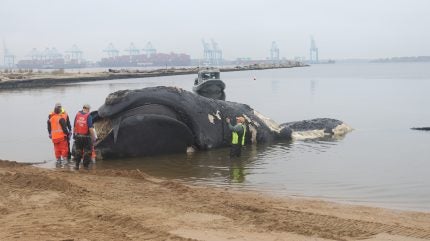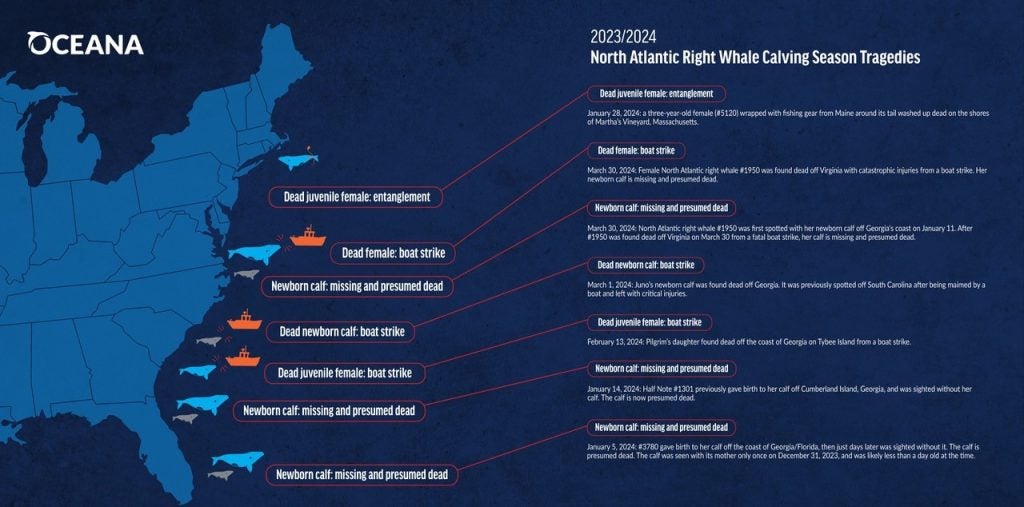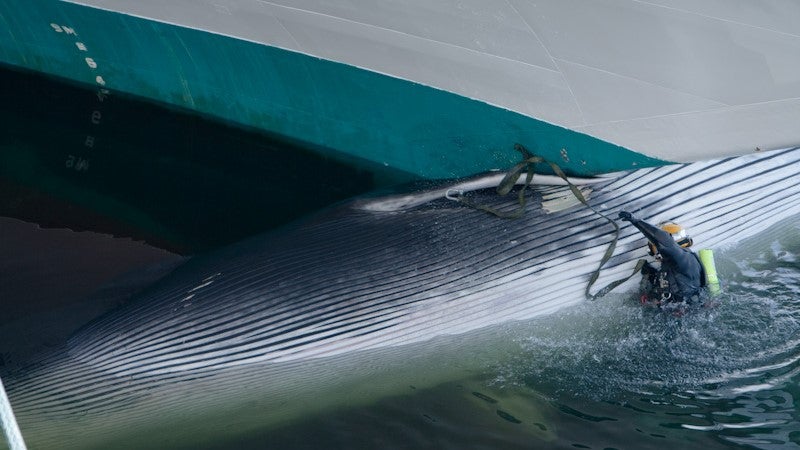
Ship strikes are a leading cause of death for whales, with an estimated 20,000 killed by collisions annually. This is particularly concerning for sub-species already facing extinction, with intensive whaling already having reduced the number of some to the hundreds. This includes North Atlantic right whales, of which only around 360 remain.
Part of the problem is that shipping lanes coincide with North Atlantic right whales’ migratory route. With US shipping ports busier than ever, the result is a high number of collisions with the whales, which are dark in colour and swim close to the surface. Conservation non-profit Oceana reported on several recent deaths in the calving season (November to May).
The tide needs to turn particularly for the US East Coast, which sees a disturbingly high number of whale deaths. The years 2018, 2019, and 2021 were some of the worst on record for collisions off the coast of California, with 10, 11, and 8 confirmed deaths, respectively.

These reported deaths are thought to represent only around 5%-17% of ship-strike mortalities, with most whales believed to sink when struck and killed. The actual annual toll in the area could be closer to 100.
The problem is set to worsen as global ocean traffic continues to rise – by an estimated 240% and upwards by 2050. Recommended speed restrictions have been put in place in an attempt to reduce fatalities, but, with 33% of vessels ignoring these recommendations in Southern California in 2023 and 30% in San Francisco, Rachel Rhodes of Whale Safe, a technology-based mapping and analysis tool designed to reduce ship strikes, warns that “we still have more work to do.”
The solution to ship strikes
Enacting a reduction in the number of collisions is not straightforward in practice, but Oceana campaign director Gib Brogan explains that it is in principle. “The answer is simple,” he says. “Ships need to slow down.”
How well do you really know your competitors?
Access the most comprehensive Company Profiles on the market, powered by GlobalData. Save hours of research. Gain competitive edge.

Thank you!
Your download email will arrive shortly
Not ready to buy yet? Download a free sample
We are confident about the unique quality of our Company Profiles. However, we want you to make the most beneficial decision for your business, so we offer a free sample that you can download by submitting the below form
By GlobalDataHowever, convincing shipping vessels and companies to slow down has not been so simple. Brogan points out that the National Oceanic and Atmospheric Administration (NOAA) Vessel Speed Rule was introduced in 2008, but says that: “Since then, the population [of North Atlantic right whales] has rapidly declined and shifted, making updates necessary.” He adds that “it’s clear voluntary speed limits don’t work.”
Whale Safe, a programme developed by the Benioff Ocean Science Laboratory (BOSL) at the University of California, has also observed that not all shipping companies are interested in adhering to the restrictions.
The programme tracks vessels and analyses the speeds to produce ‘report cards’, which assess companies’ cooperation with speed regulations across North America and grades them on a scale of A+ to F.
Maersk most recently received a B, telling Ship Technology: “To reduce the risk of whale strikes or disturbing breeding whales, Maersk follows all mandatory speed reduction schemes at sea and has also implemented voluntary schemes, adapting to the recommended measures.”
Hapag-Lloyd received a C. It tells Shipping Technology: “Our commitment to both mandatory regulations and voluntary measures is firm … we remain steadfast in our mission to protect marine life and promote responsible shipping practices.”

Whale Safe also tracks whales using hydrophones (underwater microphones) attached to buoys alongside visual tracking to inform its near-real-time whale and ship data.
Rhodes explains: “It integrates acoustic and visual whale detections with model predictions to provide mariners with the latest information on whale presence in busy shipping areas. The near-real-time whale data is updated every hour with new information and is transmitted to ship captains and crews via a daily email alert, automated Twitter feed, and available via an Application Programming Interface (API).”
Its near-real-time whale detection and vessel analytic reporting is an attempt to better inform mariners of the likely presence of whales and to hold to account those neglecting to slow down. This month, it launched its new tool, Whale Safe North America, which expands the vessel analytics element of its platform to reach all slow-speed zones across North America.
Previously, the tool spanned the Ports of Los Angeles and Long Beach in southern California and near the Port of Oakland in the San Francisco Bay Area.
The response
Rhodes says that the tool has seen success, noting that the percentage of vessels abiding by the recommended limits had increased in Southern California from 46% in 2019 to 63% in 2023 and in San Francisco from 57% in to 70% between the same years. However, while Rhodes says the cooperation rate is trending in the right direction, she adds that Whale Safe would like to see it closer to 100%.
“We are continuing to do outreach with shipping companies, navigation software companies, and other major players in this space to try to make our data as accessible and easy to use as possible and to encourage more vessels to slow down,” she says. However, shipping companies need to be on board.
Maersk’s spokesperson would not comment on Whale Safe’s technology but tells Ship Technology: “As a company operating in a global industry, we find it important that solutions within this field are global and founded at the right regulatory bodies such as coast state authorities.”
Oceana’s Brogan hopes that regulation will become tighter and that the NOAA will increase enforcement, calling on Biden to approve the proposed updates to the Vessel Speed Rule. These would make current voluntary speed limits mandatory in dynamic slow zones, and change the rule to apply to boats 35ft or longer, rather than the current 65ft.
A spokesperson for Hapag Lloyd tells Ship Technology: “Protecting endangered whales is a critical component of our commitment to sustainability, particularly in the area of biodiversity.”
Slowing down is the inescapable solution for reducing the number of fatal collisions between ships and whales. Protecting whales will require intentional change from mariners, or tighter regulations with proper enforcement.
Oceana explains: “At high speeds, ships cannot manoeuvre to avoid them, even with advanced monitoring technologies, and the whales swim too slowly to be able to move out of the way. Limiting vessel speeds to 10 knots is estimated to reduce a North Atlantic right whale’s risk of death from a boat over 65 feet by between 80% and 90%.”







